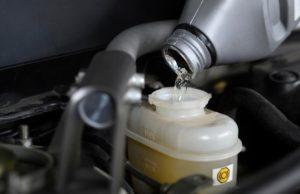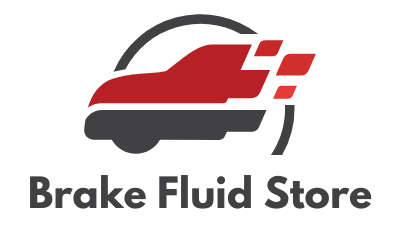Scheduled maintenance and regular inspection are critically important if you want your vehicle to work properly for a long period of time. Not only does it allow you to enjoy an optimum driving experience but it also helps you save a lot of money in the long run. Learn how to check brake fluid to determine if it needs to be changed.
Checking your vehicle’s brake fluid regularly and making sure it’s within the MAX line is one of the essential things to do to ensure your vehicle is in good shape. That’s why understanding how to check your vehicle’s brake fluid is important.
Contents
What is Brake Fluid?

Before getting into the details of checking the brake fluid, let’s discuss what it really is along with its purpose.
Brake fluid plays a key role in your car’s braking system. It allows several components of the braking system to move without any friction. When you depress your car’s brake pedal, the brake fluid transfers the power created to the braking system and converts it to hydraulic power to amplify the brake force.
Your car’s braking system won’t work without the brake fluid and the following are some other reasons why you should check your brake fluid regularly.
- Brake fluid comes with a specific amount of alcohol that can absorb moisture.
- The moisture can corrode and damage wheel cylinders, caliper cylinders, and metal lines.
- The brake master cylinder can begin to leak.
- The brake rubber seals and hoses deteriorate with the passage of time and can contaminate the brake fluid.
- The leaking brake fluid can enter the brake booster and you’ll need to replace it in such a situation.
- If you neglect your vehicle’s brake fluid service, the braking power as well as safety will suffer.
- You’ll need to spend a whole lot of money on expensive repairs if your braking system gets damaged.
How to Check Your Vehicle’s Brake Fluid?
You can use the following steps to check your vehicle’s brake fluid.
Step 1: Open Your Car’s Hood
Make sure that you start your brake fluid checking process by parking your car on a level surface and the engine should also be cold.
Step 2: Locate the Master Cylinder
Most vehicles have their master cylinder located on the driver’s side at the back of the engine bay. You’ll also see a reservoir right above the master cylinder.
Step 3: Check the Reservoir
Most new cars come with a transparent reservoir and you’ll also see lines marked “MAX” and “MIN”. Ideally, your car’s brake fluid should fall between those lines.
However, if you have a 1980s model, you’ll most probably see a reservoir made of metal. In this case, you’ll need to remove the reservoir cap. You might also need to use a screwdriver to remove the cap.
Important Note:
If the reservoir shows that your car’s brake fluid is below MIN level or at the “Add” level, you’ll need to add brake fluid. It’s also important to get your brakes inspected as soon as possible in such a scenario.
How to Check the Brake Fluid Condition?
Consider using the following steps to check the condition of your vehicle’s brake fluid.
Step 1: Check the Color of Brake Fluid
Usually, the color of the brake fluid is brown. But if you find that your vehicle’s brake fluid is black or dark, you might need to replace it. It’s advisable to take your car to the mechanic for further testing.
Step 2: Use a Chemical Test Strip
With time and constant use, the corrosion inhibitors of the brake fluid break down. You can use a chemical test strip into your brake fluid in order to check the copper’s presence. The higher the presence the more worn out or weary the corrosion inhibitors are.
Step 3: Use an Optical Refractometer
You can also use an optical refractometer to check the moisture content in your brake fluid. As mentioned earlier, the brake fluid comes with moisture absorption properties, and with time, moisture dilutes the fluid.
Not only does it weaken the braking system of your car but it can also cause the components of the braking system to corrode. With average use, your braking fluid can have up to three percent water that also decreases the boiling point of the fluid.
Step 4: Use an Electronic Tester
Using an electronic tester allows you to evaluate the boiling point of your vehicle’s brake fluid. The brake fluid with the DOT 3 specification, in a good condition, has a wet boiling point of 284 degrees Fahrenheit or 140 degrees Celsius and a dry boiling point of 401 degrees Fahrenheit or 205 degrees Celsius.
On the other hand, the DOT 4 brake fluid comes with a wet boiling point of 311 degrees Fahrenheit or 155 degrees Celsius and a dry boiling point of 446 degrees Fahrenheit or 230 degrees Celsius.
The higher the boiling point of your brake fluid the more effective it is and vice versa.
Important note
You can take your vehicle to the mechanic to get your brake fluid inspected for both moisture content and boiling point as mechanics have all the required equipment.
What to Keep in Mind While Checking Brake Fluid?
It’s important to make sure that you don’t spill your vehicle’s brake fluid on any painted surface of your car. If it happens, wash it off thoroughly with water and use a clean rag to wipe the area as soon as possible.
Make sure that no grease or oil makes its way to your vehicle’s brake fluid. That’s because the brake fluid has an entirely different chemical composition and it’ll fail to work if mixed with grease or oil. In the worst condition, your car’s braking system can be damaged severely.
What Happens If You Don’t Check Your Vehicle Brake Fluid Regularly?
Checking your vehicle’s brake fluid allows you to determine the quantity and quality of the fluid so that you can add more fluid or replace the existing one as needed.
The brake fluid allows your vehicle’s braking system to work properly. If the brake fluid is low in quality or quantity it can damage other components. The brake fluid deteriorates its quality over time and it can get contaminated with other materials such as:
- Rubber
- Metal
- Moisture
- Debris
These materials can reduce the stopping power of the braking system by decreasing the pressure transmitting capacity of the brake fluid.
FAQs
Can You Check Your Vehicle’s Brake Fluid When the Engine is Hot?
It’s advisable not to check the brake fluid when your vehicle’s engine is hot. Not only does it help you avoid getting hurt but it also provides you with more accurate results.
You should park your vehicle on a level surface and let your vehicle’s engine cool down before starting the brake fluid checking process.
Can You Drive Your Vehicle with Low Brake Fluid?
You should avoid driving your vehicle with low brake fluid at all costs as it can be extremely dangerous. Worn brake pads and low-level brake fluid are the reasons why the brake light pops up on your dashboard.
You must never drive your vehicle if the brake light is on without checking your brake fluid and brake pads.
Does Brake Fluid Get Low Very Often?
The braking system of your vehicle is completely sealed and keeps the hydraulics from leaking. That’s why brake fluid should not get low often. If you experience this problem, consider it a red flag as it indicates that there is something seriously wrong with your vehicle’s braking system. Get your vehicle’s braking system as soon as possible to find out the problem to fix it.
How Often Should You Check Your Vehicle’s Brake Fluid?
The best way to make sure that your vehicle’s brake fluid is in good condition is to get it checked during your regular maintenance and oil changing sessions. It doesn’t take much time but it’ll keep you from falling victim to dangerous brake issues.
You can also inspect your vehicle’s brake fluid yourself easily by opening the hood/bonnet and checking the master cylinder. If you have a newer model, you’ll see a transparent reservoir with “MAX” and “MIN” levels. Ideally, the brake fluid should fall somewhere between these lines.
Can You Add New Brake Fluid to the Old One?
If the quality of your current brake fluid is low, you should not add new fluid to it. That’s because the lower quality indicates that the old brake fluid has lost its effectiveness by absorbing moisture or getting contaminated.
It can corrode hydraulic components and in the worst case, it can also damage the braking system severely. On the other hand, if your brake fluid is still high in quality and has low quantity, you can add new fluid to it.
Final Thoughts
Nothing can be more frightening for any driver to find out at high speed that the vehicle’s braking system isn’t working. Understanding how to check your vehicle’s brake fluid allows you to make sure that your vehicle’s brakes work properly.
The brake fluid checking process is pretty easy and you should perform it regularly to ensure your and your family’s safety.
